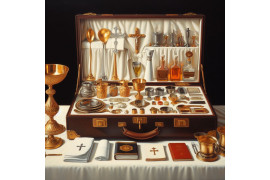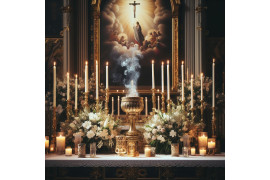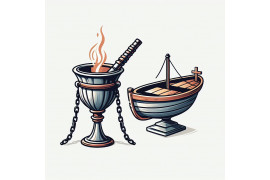Lighting a lamp holds immense significance in various cultures across the globe. This sacred act represents more than just illuminating a space; it carries deep symbolic meaning. The flame of the lamp is believed to embody divine energy, serving as a beacon of positivity and enlightenment. As darkness is dispelled by its gentle glow, the lamp becomes an icon of hope and knowledge, symbolizing the triumph over ignorance.
In many traditions, lighting a holy lamp is not merely a practical act but a spiritual ritual that connects individuals with their faith. It serves as a reminder to seek inner illumination and strive for higher understanding. Whether it is in religious ceremonies or personal devotions, the lighting of the holy lamp serves as a powerful visual metaphor for embracing light and dispelling darkness.
Rituals and Ceremonies Associated with Lamp Lighting
Lamp lighting ceremonies are an integral part of various religious festivals and traditions. These ceremonies hold deep significance and are performed by devotees to offer prayers and seek blessings from deities. Let's explore the rituals and ceremonies associated with lamp lighting.
Common during Religious Festivals
During religious festivals, lamp lighting is a common practice in temples, homes, and other sacred spaces. It serves as a way to illuminate the surroundings both literally and symbolically. Devotees light lamps using oil or candles as a means of expressing their devotion and reverence towards the divine.
Offering Prayers while Lighting Lamps
When lighting a lamp, devotees often engage in prayerful activities. They may chant mantras or recite hymns to invoke blessings from the deities they worship. This act of offering prayers while lighting lamps is believed to create a spiritual connection between the individual and the divine.
Special Rituals for Invoking Blessings
In addition to offering prayers, there are specific rituals associated with lamp lighting that vary across different religions and traditions. For example, in some Hindu rituals, lamps are lit using ghee (clarified butter) or camphor, which is believed to purify the environment and ward off negative energies.
Importance in Orthodox Christian Worship
In Orthodox Christian worship, lamp lighting holds great importance. The sanctuary lamp, also known as the eternal flame or vigil lamp, is continuously lit near the altar as a symbol of God's presence. This lamp signifies Christ as "the Light of the World" and remains lit at all times during church services.
Lamp Lighting in Burial Rites
Lamp lighting also plays a role in burial rites in certain cultures. In some traditions, an oil lamp is placed near the deceased person's body during funeral services or wakes as a symbolic representation of their journey into the afterlife. This act is seen as a way to guide the departed soul on their spiritual path.
Participation in Religious Meetings
In religious meetings or gatherings, lamp lighting ceremonies often mark the beginning or end of an event. It serves as a way to create a sacred atmosphere and invoke blessings for the occasion. Participants may take turns lighting lamps as a symbol of unity and collective participation in the spiritual experience.
Symbolism in Baptism and Holy Communion
Lamp lighting also holds significance during sacraments such as baptism and holy communion. In some Christian traditions, a candle is lit during baptism to represent the light of Christ entering the life of the newly baptized individual. Similarly, candles are often used during holy communion to symbolize Christ's presence.
Importance of Oil Lamps and Diyas in Religious Practices
Oil lamps, also known as diyas, hold immense cultural and religious significance in various traditions such as Hinduism, Buddhism, and Sikhism. These lamps play a vital role in rituals and festivals, symbolizing devotion, purity, and enlightenment.
Oil Lamps in Hindu, Buddhist, and Sikh Traditions
In Hinduism, the lighting of oil lamps is an integral part of daily prayers (puja) conducted in homes or temples. The puja room is adorned with beautifully decorated oil lamps that create a serene atmosphere. Mustard oil or desi ghee is commonly used to fuel these lamps. The flickering flame represents the presence of divine energy and is believed to ward off negative energies.
Similarly, in Buddhism, oil lamps are lit during meditation practices to enhance focus and create a peaceful ambiance. The gentle glow of the lamp aids practitioners in achieving a state of tranquility and mindfulness.
Sikhism also embraces the use of oil lamps called "deepam" during religious ceremonies. These lamps are often fueled by coconut oil and are lit to honor Guru Nanak Dev Ji's teachings on spiritual enlightenment.
Significance during Festivals like Diwali
One of the most prominent festivals where diyas take center stage is Diwali, also known as the Festival of Lights. During this joyous occasion celebrated by Hindus worldwide, homes are illuminated with rows of brightly lit diyas. This tradition signifies the triumph of light over darkness and good over evil.
The lighting of these clay lamps adds warmth to the surroundings and symbolizes inner awakening and spiritual enlightenment. It is believed that Goddess Lakshmi visits homes that are well-lit with diyas during Diwali, bringing prosperity and happiness.
Fuel for Oil Lamps: Mustard Oil or Desi Ghee
Mustard oil holds great significance. It is believed to possess purifying properties and is often used in religious ceremonies. The aroma of mustard oil is said to ward off negative energies and create a positive environment.
Desi ghee, clarified butter made from cow's milk, is also commonly used as a fuel for oil lamps. It is considered pure and auspicious in Hindu rituals.
Beliefs and Reasons behind Lighting Lamps
People believe that lighting lamps brings prosperity and good fortune
Lighting lamps holds a significant place in various religious practices across different cultures. Many people firmly believe that by lighting candles or oil lamps, they can invite prosperity and good fortune into their lives. It is seen as a way to attract positive energies and blessings from the divine.
It is believed to ward off negative energies and evil spirits
One of the main reasons why people light lamps is to protect themselves from negative energies and evil spirits. The act of lighting a lamp is thought to create an aura of positivity, dispelling any darkness or negativity that may be present. By doing so, individuals hope to cleanse their surroundings and ensure a harmonious environment.
Lamps are lit as an offering to seek blessings from deities
In many religious traditions, lighting lamps is considered an important offering made to deities during prayers or rituals. By illuminating the lamp, individuals express their devotion and seek blessings from the gods or goddesses they worship. This act symbolizes surrendering oneself to a higher power and seeking guidance in life's journey.
Lighting lamps represents knowledge and dispelling ignorance
The symbolism associated with lighting lamps goes beyond just physical illumination. In many spiritual traditions, it represents the kindling of knowledge within oneself and dispelling ignorance. Just as a lamp lights up a room, knowledge enlightens one's mind, leading them on the path of wisdom.
The benefits extend beyond religious beliefs
While the act of lighting lamps has deep-rooted religious significance, its benefits are not limited to those who follow specific faiths or religions. The serene glow of a lamp can have a calming effect on one's mind, creating an atmosphere conducive for meditation or introspection. It serves as a reminder to pause amidst the chaos of daily life and find solace within.
Historical Context and Traditions of Lamp Lighting
Lamp lighting is a tradition that has been practiced for centuries across various civilizations. Ancient scriptures, such as the Old Testament and the New Testament, mention the importance of lamp lighting rituals in religious and cultural contexts.
In ancient times, lamps were used as a primary source of light before electricity was invented. They played a crucial role in illuminating homes, temples, and public spaces. Lamp lighting held significant symbolic meaning, representing the dispelling of darkness and the arrival of light.
Different regions have their own unique traditions associated with lamp lighting. For example:
Ancient Scriptures and Lamp Lighting
Ancient texts like the Old Testament mention lamp lighting as a sacred practice. In the story of Hanukkah, for instance, it is believed that a small amount of oil miraculously lasted eight days when a holy lamp was lit in Jerusalem's temple.
Cultural Significance
Lamp lighting is confined to religious practices and holds cultural significance in many societies. It is often seen during festivals or celebrations as a way to create an atmosphere of joy and festivity.
Symbolism
Lamp lighting symbolizes enlightenment, knowledge, and spiritual awakening. It represents the triumph of good over evil and serves as a reminder to individuals to strive for inner illumination.
Regional Traditions
Different regions have their own unique traditions associated with lamp lighting. For example:
-
In India, Diwali (the Festival of Lights) involves lighting traditional oil lamps called diyas to celebrate the victory of light over darkness.
-
In Japan, there is a tradition called Bon Odori where lanterns are lit to guide ancestral spirits back home during Obon festival.
-
In Christian traditions, candles are often lit during prayer or worship services symbolizing Christ as the light of the world.
Art, Architecture, and Chapels related to Lamp Lighting
Temples, churches, and other holy places often incorporate lamps into their art, architecture, and chapels. These elements play an essential role in the religious practices and traditions of various faiths. Let's explore some fascinating aspects of lamp lighting in these sacred spaces.
Temples with Intricate Lamp Designs
One captivating aspect of temples is their intricate designs that incorporate lamps. These structures are not just places of worship but also architectural marvels that showcase the devotion and creativity of the people who built them. Lamps are strategically placed throughout these temples to create a serene ambiance and symbolize spiritual enlightenment.
Traditional Art Depicting Lamp Lighting Ceremonies
In addition to architectural designs, traditional art forms often depict scenes of lamp lighting ceremonies. These artworks provide a glimpse into the cultural significance attached to this practice. Paintings, sculptures, and murals portray devotees offering prayers while lighting lamps as an act of reverence towards their deities.
Chapels Dedicated to Lamp Offerings
Chapels within churches or basilicas may have special arrangements for lamp offerings. These dedicated spaces allow individuals to light lamps as a form of prayer or remembrance for loved ones. The flickering flames create an atmosphere of tranquility and serve as a visual representation of hope and divine presence within these sacred spaces.
Significance in Holy Sepulchre and Early Churches
The Holy Sepulchre in Jerusalem holds immense importance for Christians worldwide. This holy site contains the tomb where Jesus Christ was laid after his crucifixion. Within this revered place lies the Chapel of the Angel, which has a unique tradition related to lamp lighting. Each year on Holy Saturday during the Easter Vigil service, church leaders ceremoniously light a large candle from an oil lamp hanging inside this chapel.
Lamp lighting also played a significant role in early Christian churches. It served both practical and symbolic purposes. The light from the lamps illuminated the dim interiors, allowing believers to see and participate in church meetings. Symbolically, the lamps represented spiritual illumination and guidance.
Restoration and Preservation of Lamp Lighting Traditions
Over time, some lamp lighting traditions may have evolved or faded away. However, efforts are being made to restore and preserve these practices in various holy places. This restoration work helps maintain the cultural heritage associated with lamp lighting ceremonies and ensures that future generations can continue to experience their beauty and significance.
Understanding the Spiritual Power of Lamp Lighting
By delving into these topics, we can gain a more profound understanding of the spiritual power behind lamp lighting.
Lamp lighting holds immense significance in many cultures and religions around the world. It is believed to symbolize the triumph of light over darkness and knowledge over ignorance. The act of lighting a lamp is seen as a way to invite positive energy into one's life and surroundings. Whether it be through the flickering flame or the soothing glow that emanates from it, lamp lighting has a calming effect on individuals and creates an ambiance conducive to prayer, meditation, or reflection.
To truly experience the transformative power of lamp lighting for yourself, consider incorporating this practice into your daily routine or during special occasions. Take a moment each day to light a lamp with reverence and mindfulness. Observe how it brings about a sense of peace and serenity within you. Allow yourself to connect with the ancient traditions that have upheld this practice for centuries.
FAQs
What kind of oil should I use for lamp lighting?
It is recommended to use pure oils such as ghee (clarified butter), sesame oil, or mustard oil for lamp lighting. These oils are considered auspicious in many religious traditions due to their purity and ability to produce a steady flame.
Can I use electric lamps instead of traditional oil lamps?
While electric lamps may be convenient and safer in certain situations, traditional oil lamps hold greater spiritual significance due to their connection with ancient rituals and traditions. If possible, it is advisable to use traditional oil lamps for ceremonial purposes.
How often should I light a lamp?
The frequency of lamp lighting depends on personal preference and religious practices. Some individuals prefer to light lamps daily as part of their spiritual routine, while others may do so on specific occasions or festivals. It is best to follow the customs and traditions that resonate with you.
Are there any specific prayers or mantras associated with lamp lighting?
Yes, there are various prayers and mantras associated with lamp lighting in different religious traditions. These prayers often express gratitude, seek blessings, or invoke divine presence. Consult your religious texts or seek guidance from a spiritual leader for appropriate prayers or mantras.
Can I use scented oils for lamp lighting?
While scented oils may create a pleasant aroma, it is generally recommended to use unscented oils for lamp lighting. The focus is primarily on the flame and the symbolism it represents rather than the fragrance emitted by the oil.
How can I maintain the cleanliness of my lamps?
Regular cleaning of lamps is essential to ensure their proper functioning and longevity. Use a soft cloth or sponge to wipe away any residue from previous usage. Avoid using harsh chemicals that may damage the lamp's surface.
Is there any specific time of day when lamp lighting is more effective?
Lamp lighting can be done at any time of day; however, certain periods such as dawn and dusk are considered particularly auspicious for this practice. These transitional moments between light and dark hold special significance in many spiritual traditions.



